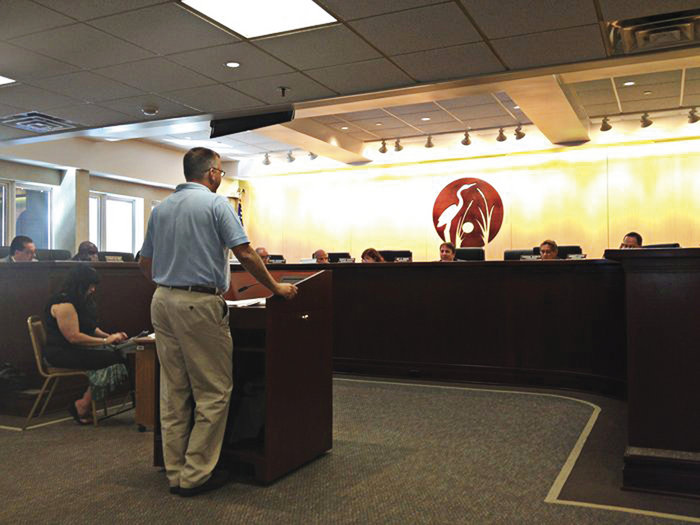After years of fighting to pay less into the Meadowlands inter-municipal tax-sharing program, Secaucus may see a significant reduction.
Members of the Hackensack Meadowlands Municipal Committee (HMMC) earlier this month narrowly voted to change the tax sharing formula’s base year from 1970 to 2004, a change which Mayor Michael Gonnelli helped herald through major campaigning on the issue throughout the year. The vote was 7 to 3 plus 3 abstentions.
The state’s tax sharing program began in the early 1970s as a way to offset the loss of tax ratables for some of the 14 Meadowlands district towns that couldn’t develop because land had been degraded by landfills. A 1969 state survey revealed that more than 5,000 tons of waste had been brought into the Meadowlands every day, six days a week, 300 days a year. The creation of the New Jersey Meadowlands Commission (NJMC) at the time was a step toward reclaiming the land and regulating the 51 landfills in the district.
“You had a paradigm shift in what you can and can’t develop in 2004.” – David Drumeler
____________
If the change takes effect, Secaucus’s tax sharing contribution will plummet, from $3 million to $723,504. The amendment must be approved by the state legislature and the governor for it to take effect.
While the change in the base year will mean Secaucus will keep more of its local tax revenue, for Kearny the change means a dramatic loss. They used to receive over $3 million but now they’ll pay out more than $200,000 – which has certain local officials feeling conflicted about the proposal, including Assemblyman Vincent Prieto, who represents both towns in the legislature.
Renewed environmental preservation in 2004
The town of Secaucus hired Robert Ceberio as a consultant to conduct a comparative analysis between the original 1970s Meadowlands District Master Plan and its 2004 revision. Ceberio is the former executive director of the NJMC from 2002 to 2010. He had also worked at the NJMC in various capacities since 1989, including the role of director of planning and management. Ceberio led the 2004 revision of the master plan, which designated more land for preservation and identified areas for redevelopment including brownfields, former industrial sites affected by contamination.
In his analysis he included a chart that offers a side-by-side comparison between new development available in 1970 versus 2004. While commercial square footage went up from 3 million square feet to nearly 7 million square feet, residential units went down from 70,000 to 3,741, and available industrial and warehouse space went from 90 million square feet to 12 million square feet.
“You had a paradigm shift in what you can and can’t develop in 2004,” said Town Administrator David Drumeler. “Our argument is, ‘you need to update the tax sharing formula for what that is.’”
He said that the chart demonstrates how much less land exists for new development, and that the portion of developable land in Secaucus shrunk in 2004, whereas Kearny has redeveloped land since then, including former brownfields. Because less land is available for new development based on the 2004 assessment, the tax sharing pot of money goes from approximately $7 million to $2 million.
“All of the land left in the district is redevelopment,” noted Drumeler. “Using 1971 as a base year is not rationally related to the reality after the new master plan because the new master plan reduced so much developable land in Secaucus, specifically, and in the Meadowlands, generally.”
State and legislative approvals
Drumeler said Secaucus is working with Department of Community Affairs Commissioner Richard Constable to come up with a solution for tax sharing. A press spokesperson for Gov. Christopher Christie said “the administration continues to be broadly open to a change in the sharing program, but continues to believe that any proposal must originate in the legislature.”
Prieto, who serves as the budget chairperson in the Assembly, said last week that he plans to reach out to the Department of Community Affairs commissioner and the administration to get their thinking on the matter, and find out whether the legislation is something the governor would ultimately sign.
Prieto said that he feels conflicted about the current proposal because he represents both Secaucus and Kearny, and he wouldn’t want to see an unfair scenario for either town.
“We want to make sure everyone is protected,” said Prieto. “I have to be fair.”
He said that if tax sharing ceased today it would have an adverse affect, especially on towns like Kearny that would have the “rug pulled out from under them.” On the other hand, he said that he “would love to see Secaucus paying zero…because throughout the years they have paid enough into tax sharing.”
Prieto said that Kearny would likely need additional aid from the state if the tax sharing formula were to change. Throughout the past he has made a number of suggestions for alternative sources of funding such as placing a $1 surcharge on area hotels or on parking at events held at MetLife Stadium.
“As far as I’m concerned, Kearny has been helped for the last 42 years, it is time to help us,” said Gonnelli.
“If you have a majority of the mayors in the area that want this change, generally the majority rules,” noted Gonnelli. “I hope legislators see that the majority of us want change.”
Adriana Rambay Fernández may be reached at afernandez@hudsonreporter.com.
